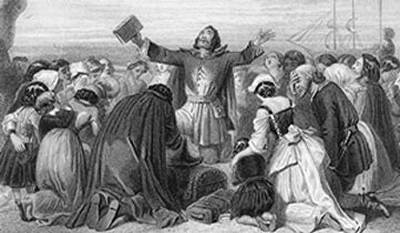 |
| Puritan Non-Conformist Worship |
The Puritans were a religious group that attempted to reform the Church of England. They believed in a simple form of church where the Bible was strictly the word of God. The term Puritan comes from the idea of the purification of the church. This religious group of people sought to eliminate all the ties to Catholicism. Puritans believed that people should be able to worship in their own way. The Catholic religion opposed this train of thought and believed that the uniformity of religion must be present in any society. The church eventually grew tired of the Puritan demands of reformation and forced them to conform. Puritans were then persecuted in England as traitors if they continued to insist on reforming the Church of England. William Laud became the Archbishop of Canterbury in 1630 as head of the Anglican Church. After receiving this position, Laud began to exercise his power and became more and more repressive. This caused some Puritans to set out to New England where they could establish their church and worship God in their own way separate from the Church of England. Others chose to stay and became a power within the Parliamentarian Party and defeated Charles I in the English Civil War (1642-1651). Puritan control remained until 1660 when the monarchy was restored under Charles II who reinstated Anglicanism. This forced Puritan Clergy out under the terms of the Act of Uniformity in 1662. Due to this reinstatement, English Puritans were titled as Nonconformists.